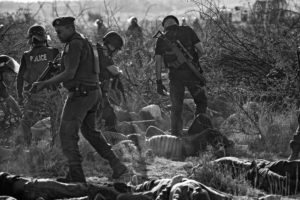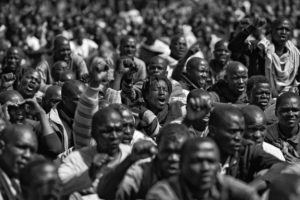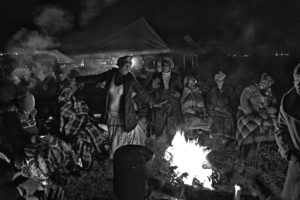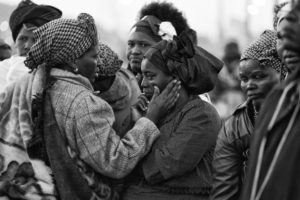The Marikana massacre, which took place exactly 10 years ago on 16 August 2012, was a horrific watershed moment for post-apartheid South Africa.
It was the most deadly use of violence by the South African security forces against its own civilians since the Sharpeville massacre.
Multi-award winning Jewish photojournalist Alon Skuy was there to document the horror of this deadly event. His work from this time was documented in a book called Marikana 2012/2022, launched at the Johannesburg Holocaust & Genocide Centre in Parktown on 3 July.
Skuy created the book from this deadly event because he “wanted to put a record together to honour the unity and resolution of the miners and community fighting for a living wage, and to pay tribute to the memory of those that perished”.
He told the SA Jewish Report this week, “I wanted to reflect the awful senselessness of the day and the far reaching repercussions, and to have a physical representation as well as a digital record of this watershed moment in South Africa’s history.”
The Johannesburg Holocaust & Genocide Centre was the perfect place for the launch, said Skuy, because it’s “a solemn and important institution that reflects pain and hope”.




For Skuy, the events of Marikana were “extremely difficult to photograph and process”. It was “one of the lowest points in South Africa’s democracy”.
“The far reaching consequences and pain for the families and communities are still so deeply felt, and many still don’t have closure,” he said.
Considering the events, he said, “After the events at scene one [when the police shot the first 17 striking miners], it wasn’t immediately clear what had happened. It was important to document what was accessible to have a starting point and record of the tragedy.
“The images are confronting and hard to look at. They aim to be a humble contribution to the many other records along with other photographers and investigative journalists. The events of scene two [which took place 15 minutes after scene one, when another 17 miners were killed without the media being able to cover it] came to light only in the weeks and months after 16 August 2012.”
Having since emigrated to Miami in the United States, Skuy said that looking back after 10 years, “I would hope that the events serve as a lesson about the sanctity of life, and how healing is an ongoing process.”
Looking back at his career to date, Skuy describes Marikana as “one of the most significant and haunting” of his photographic experiences – and he has covered a plethora of violent, volatile, and traumatic events including the ongoing scourge of xenophobic violence in South Africa over the past decade, the earthquake in Haiti, and famine in Somalia.
He has never been able to forget the image from the Marikana massacre of “a police officer gesturing to a severely injured miner to stay down on the ground after many of his fellow workers had been killed beside him”. This still haunts Skuy 10 years on.
Skuy’s book of photographs is contextualised by the words of journalist Ufrieda Ho.
Writing about Skuy’s book, journalist Niren Tolsi said, “Alon Skuy’s unflinching photographs document the moments leading up to, during, and after, the massacre at scene one. They go on to document the grief that accompanies death before sensitively exploring the socio-economic conditions that still wrack mining towns like Marikana because the government won’t hold mining companies to account for their deficient transformation record. Skuy demands that we look not just at Marikana and the massacre it has become synonymous with, but how these are connected to our own lives and what kind of country and world we’d like to live in. This book behoves us to imagine something beyond individual interest. It asks us to relocate our humanity among pages that reflect violence, trauma, grief, inequality, and injustice and to rekindle our solidarity with each other.”
Skuy has given the SA Jewish Report permission to use his photographs in commemoration of this deadly day in our history.